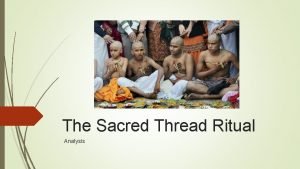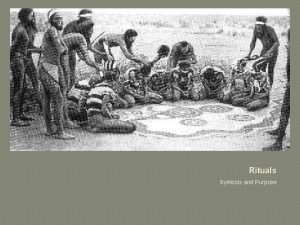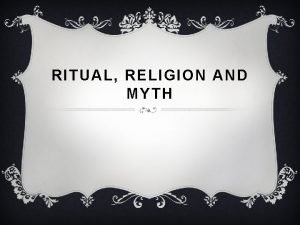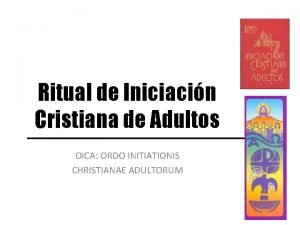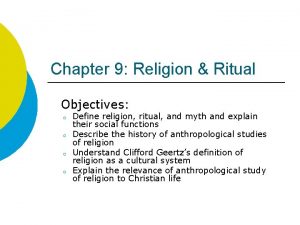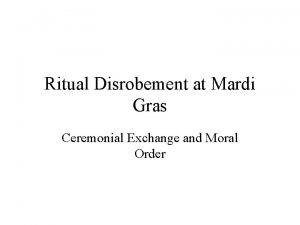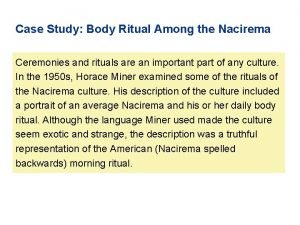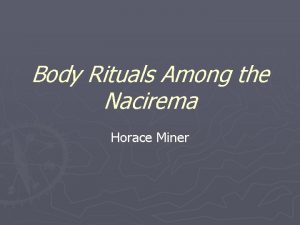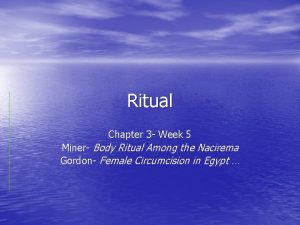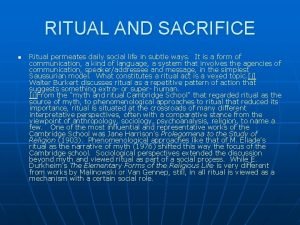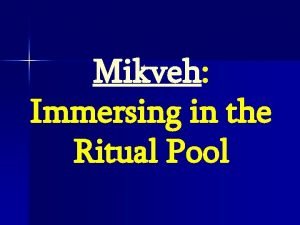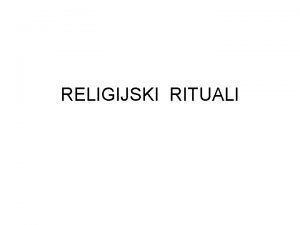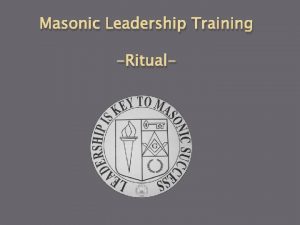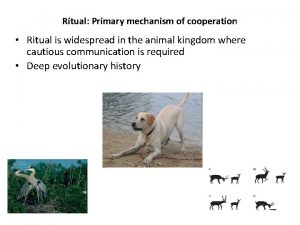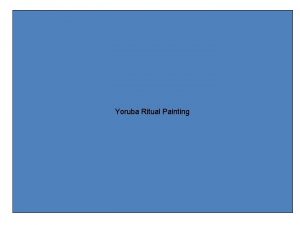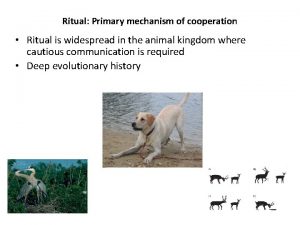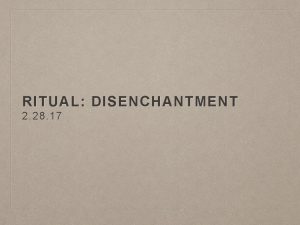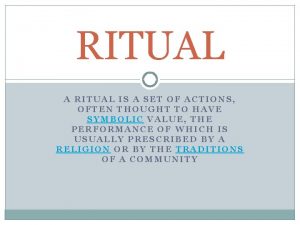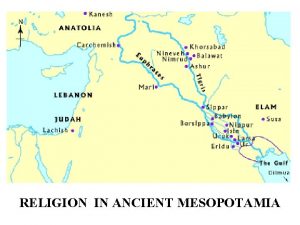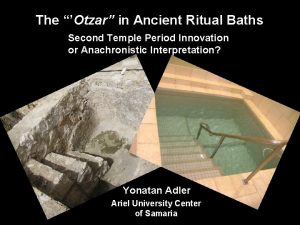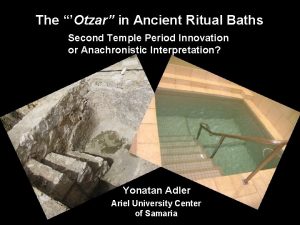RITUAL General Characteristics of Ancient Religion religion nonelective






















- Slides: 22

RITUAL

General Characteristics of Ancient Religion • religion non-elective • religion not revealed • role of ancestral custom (nomos) • religion public, rarely private • religion non-eschatological • focus on practice, not belief (orthopraxy) • emphasis on communal well-being • broad tolerance for variation

orthodoxy vs. orthopraxy

“Modern” Religious Authority epiphany/revelation founder(s) text interpretation (dogma) institutionalization clerical order laity

orthopraxy • absence of revelation • absence of centralized religious institution • absence of specialized, permanent priesthood • local, pluralized nature of nomos (legomena + dromena) • practical (NOT doctrinal) role of divination • interpenetration of secular and sacred

Non-Revelatory Religions deity signs divination community

Traditional Religious Authority {deity} narrative (legomena) custom (nomos) ritual activity (dromena) {institutionalization} {priesthood} community

Priesthood • priest (hiereus) elected, appointed, bought • hereditary priesthood as “guild” (ritual as craft/technology) • priesthood often temporary • priestly access to sanctuary not exclusive • priesthood specific (incl. gender) to specific god at specific shrine • priest responsible for management (economic, legal) of sanctuary • priesthood salaried with portions of sacrificed victims • priest responsible for conducting public sacrifice • priest as intermediary between deity and community • priestly mediation not exclusive




Temple of Amphiaraeus at Oropos

Amphiaraos

Inscription (IG VII. 235) …the priest of Amphiaraos is to go to the sanctuary when winter arrives until the sowing season with no greater interval than three days between visits, and is to be in residence not less than ten days each month… If anyone commits a crime within the sanctuary…the priest has authority to fine him up to a maximum of five drachmas… Should he pay the fine, he is to deposit it in the treasury in the presence of the priest. If anyone suffers private injury in the sanctuary…the priest is to give judgment up to a maximum of three drachmas; as for larger sums, the judgments provided in the laws for each plaintiff are to be in effect here too…

When someone comes to be healed by the god, he is to donate a firstfruit offering of at least nine obols of silver, and deposit it in the treasury in the presence of the priest. When he is present, the priest is to say the prayers over the sacrifices and place the victim on the altar; when he is absent, the person making the sacrifice is to do this. During the public sacrifice each person is to say the prayers for himself, but the priest is to say them over the public sacrifices, and he is to receive the skin of all the victims sacrificed within the sanctuary. No portions of meat are to be carried out of the precinct. Sacrificers are to donate the shoulder-portion of each victim to the priest except during a festival; at that time he is to receive the shoulder-portion only from the public victims.

Priesthood of Amphiaraeus Legal • limited powers of adjudication of crimes and torts within sanctuary • fines deposited in temple treasury Ritual • prayer over sacrificial victim, placement on altar • primary role in public sacrifice • receipt of pelt of both private and public victims • receipt of shoulder portion of public victim in festival worship, private victim in private worship

Ritual Occasions STABLE / RECURRENT Birth Legitimization (Amphidromia) Membership Puberty Sexual Initiation Marriage Adulthood Planting/Harvesting Pregnancy Childbirth Death Annual Renewal ritual : complex of actions performed in the name of an individual or community with regularity and relative invariance

Communal Hearth Royal Hearth Throne Room, Palace of Nestor at Pylos Robert H. Consoli

Mythology of Fire SPECIES PREPARATION LONGEVITY animal raw meat short-lived human cooked meat longer-lived deity incinerated meat (smoke) immortal • warmth • food preparation (raw cooked) • stranger guest • sacrifice

Amphidromia Hearth fire as transformative: • Myths of “immortalization” (Achilles, Demophoön) • Raw Cooked : Nature Culture : Strange Familiar : Other Self • Amphidromia ritual

Amphidromia pais aph’ Hestias (child from Hestia)

Ritual Occasions AD HOC / OCCASIONAL Travel Integration Competition Hunt War Curse Sickness Interrogation
 Means of communication in ancient times
Means of communication in ancient times Ancient india vs ancient china
Ancient india vs ancient china 221 ad
221 ad Religion of sparta
Religion of sparta Secneer
Secneer Terence lovat ritual analysis
Terence lovat ritual analysis Example of rituals
Example of rituals Anthropomorphism examples
Anthropomorphism examples Ritual of the secular franciscan order
Ritual of the secular franciscan order Ordo initiationis christianae adultorum
Ordo initiationis christianae adultorum Ritual or expressive model of communication
Ritual or expressive model of communication Kinship by ritual
Kinship by ritual Ritual definition sociology
Ritual definition sociology Type of rituals
Type of rituals Unfaithful wife archetype examples
Unfaithful wife archetype examples Loyal retainer archetype
Loyal retainer archetype Ritual analysis
Ritual analysis Ritual disrobement
Ritual disrobement Ibadah aspek ritual umat islam
Ibadah aspek ritual umat islam Ekkylema
Ekkylema Body ritual among the nacirema a case study answers
Body ritual among the nacirema a case study answers Charm box nacirema
Charm box nacirema Shabbier definition
Shabbier definition





